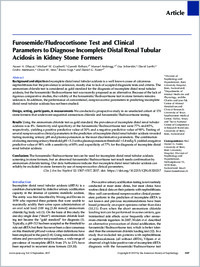Furosemide/Fludrocortisone Test and Clinical Parameters to Diagnose Incomplete Distal Renal Tubular Acidosis in Kidney Stone Formers.
- Dhayat NA Division of Nephrology and Hypertension, Bern University Hospital, Bern, Switzerland.
- Gradwell MW Division of Nephrology and Hypertension, Bern University Hospital, Bern, Switzerland.
- Pathare G Division of Nephrology and Hypertension, Bern University Hospital, Bern, Switzerland.
- Anderegg M Division of Nephrology and Hypertension, Bern University Hospital, Bern, Switzerland.
- Schneider L Division of Nephrology and Hypertension, Bern University Hospital, Bern, Switzerland.
- Luethi D Division of Nephrology and Hypertension, Bern University Hospital, Bern, Switzerland.
- Mattmann C Division of Nephrology and Hypertension, Bern University Hospital, Bern, Switzerland.
- Moe OW Departments of Internal Medicine and Physiology, and the Charles and Jane Pak Center of Mineral Metabolism and Clinical Research, University of Texas Southwestern Medical Center, Dallas, Texas; and.
- Vogt B Division of Nephrology and Hypertension, Bern University Hospital, Bern, Switzerland.
- Fuster DG Division of Nephrology and Hypertension, Bern University Hospital, Bern, Switzerland; Daniel.Fuster@insel.ch.
- 2017-08-05
Published in:
- Clinical journal of the American Society of Nephrology : CJASN. - 2017
Acidosis, Renal Tubular
Ammonium Chloride
Ammonium Compounds
Diagnostic Tests, Routine
Fasting
Fludrocortisone
Furosemide
Kidney Calculi
Potassium
Prevalence
Prospective Studies
Sensitivity and Specificity
clinical nephrology
kidney stones
mineral metabolism
renal tubular acidosis
Acidosis, Renal Tubular
Adult
Ammonium Chloride
Female
Fludrocortisone
Furosemide
Humans
Kidney Calculi
Kidney Function Tests
Male
Middle Aged
Predictive Value of Tests
Prevalence
Prospective Studies
Reproducibility of Results
Sodium Potassium Chloride Symporter Inhibitors
Switzerland
English
BACKGROUND AND OBJECTIVES
Incomplete distal renal tubular acidosis is a well known cause of calcareous nephrolithiasis but the prevalence is unknown, mostly due to lack of accepted diagnostic tests and criteria. The ammonium chloride test is considered as gold standard for the diagnosis of incomplete distal renal tubular acidosis, but the furosemide/fludrocortisone test was recently proposed as an alternative. Because of the lack of rigorous comparative studies, the validity of the furosemide/fludrocortisone test in stone formers remains unknown. In addition, the performance of conventional, nonprovocative parameters in predicting incomplete distal renal tubular acidosis has not been studied.
DESIGN, SETTING, PARTICIPANTS, & MEASUREMENTS
We conducted a prospective study in an unselected cohort of 170 stone formers that underwent sequential ammonium chloride and furosemide/fludrocortisone testing.
RESULTS
Using the ammonium chloride test as gold standard, the prevalence of incomplete distal renal tubular acidosis was 8%. Sensitivity and specificity of the furosemide/fludrocortisone test were 77% and 85%, respectively, yielding a positive predictive value of 30% and a negative predictive value of 98%. Testing of several nonprovocative clinical parameters in the prediction of incomplete distal renal tubular acidosis revealed fasting morning urinary pH and plasma potassium as the most discriminative parameters. The combination of a fasting morning urinary threshold pH <5.3 with a plasma potassium threshold >3.8 mEq/L yielded a negative predictive value of 98% with a sensitivity of 85% and a specificity of 77% for the diagnosis of incomplete distal renal tubular acidosis.
CONCLUSIONS
The furosemide/fludrocortisone test can be used for incomplete distal renal tubular acidosis screening in stone formers, but an abnormal furosemide/fludrocortisone test result needs confirmation by ammonium chloride testing. Our data furthermore indicate that incomplete distal renal tubular acidosis can reliably be excluded in stone formers by use of nonprovocative clinical parameters.
Incomplete distal renal tubular acidosis is a well known cause of calcareous nephrolithiasis but the prevalence is unknown, mostly due to lack of accepted diagnostic tests and criteria. The ammonium chloride test is considered as gold standard for the diagnosis of incomplete distal renal tubular acidosis, but the furosemide/fludrocortisone test was recently proposed as an alternative. Because of the lack of rigorous comparative studies, the validity of the furosemide/fludrocortisone test in stone formers remains unknown. In addition, the performance of conventional, nonprovocative parameters in predicting incomplete distal renal tubular acidosis has not been studied.
DESIGN, SETTING, PARTICIPANTS, & MEASUREMENTS
We conducted a prospective study in an unselected cohort of 170 stone formers that underwent sequential ammonium chloride and furosemide/fludrocortisone testing.
RESULTS
Using the ammonium chloride test as gold standard, the prevalence of incomplete distal renal tubular acidosis was 8%. Sensitivity and specificity of the furosemide/fludrocortisone test were 77% and 85%, respectively, yielding a positive predictive value of 30% and a negative predictive value of 98%. Testing of several nonprovocative clinical parameters in the prediction of incomplete distal renal tubular acidosis revealed fasting morning urinary pH and plasma potassium as the most discriminative parameters. The combination of a fasting morning urinary threshold pH <5.3 with a plasma potassium threshold >3.8 mEq/L yielded a negative predictive value of 98% with a sensitivity of 85% and a specificity of 77% for the diagnosis of incomplete distal renal tubular acidosis.
CONCLUSIONS
The furosemide/fludrocortisone test can be used for incomplete distal renal tubular acidosis screening in stone formers, but an abnormal furosemide/fludrocortisone test result needs confirmation by ammonium chloride testing. Our data furthermore indicate that incomplete distal renal tubular acidosis can reliably be excluded in stone formers by use of nonprovocative clinical parameters.
- Language
-
- English
- Open access status
- bronze
- Identifiers
-
- DOI 10.2215/CJN.01320217
- PMID 28775126
- Persistent URL
- https://folia.unifr.ch/global/documents/106916
Statistics
Document views: 20
File downloads:
- fulltext.pdf: 0
